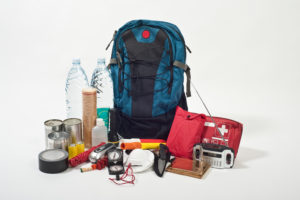 For every family and individual, it’s essential to be ready for the unexpected with an emergency preparedness kit. Situations like natural disasters, utility failures, or political unrest can and do happen. These events will leave you without access to your normal resources and supply chain for often a few days. While long term emergencies are a possibility, the most common length of time that you may be without water and power is 48 hours. That is why you should always have an emergency 48-hour survival kit on hand. This kit should include (at the least) food and water, light sources, sanitation items, first aid, and essential tools.
For every family and individual, it’s essential to be ready for the unexpected with an emergency preparedness kit. Situations like natural disasters, utility failures, or political unrest can and do happen. These events will leave you without access to your normal resources and supply chain for often a few days. While long term emergencies are a possibility, the most common length of time that you may be without water and power is 48 hours. That is why you should always have an emergency 48-hour survival kit on hand. This kit should include (at the least) food and water, light sources, sanitation items, first aid, and essential tools.
The Basics for Your 48 Hour Kit
While packing an emergency kit can seem like a large task, it is important to only pack things you need. Even though you are most likely to use it at home, keeping your kit compact and portable is also important so that you could grab it and go if need be. Store your kit somewhere dry and easily accessible.
Water & Non-Perishable Food
Arguably the most important thing you should include in your bug out kit is water. Ensuring you have drinkable water is extremely important, especially if your emergency occurs during hot weather. The average amount of water a person is supposed to drink a day is 13.5 cups a day, so you want to make sure you have enough for you and the people you are with. Understandably, packing a lot of water in your 48 hour kit can become heavy so consider purchasing a filtration straw that allows you to drink unfiltered water if it comes to that.
Additionally, you should make sure you have food in your kit. Pack healthy, easy to store, non-perishable food that you can eat at any time. You want your food to have nutritional value so food like canned meats or fish, granola bars, dry cereal, etc. are all good things to have in your kit. Several MREs (meals ready to eat) are a good idea to include as well.
Light Sources
The next most important items you should store in your 48 hour survival kit are light sources. Nothing is worse than not knowing what your surroundings are in an emergency situation. Many emergency situations can lead to power outages so being prepared with alternative lighting sources is essential.
For a portable light source, include one or two bright and long lasting flashlights in your 48 hour survival kit. If you have access to power in the form of a generator or solar powered outlets a rechargeable flashlight should be fine, but an AA battery light can be better for a long term emergency event. It is also a good idea to include a lantern in your emergency kit to illuminate larger spaces for more comfortable use in living spaces at night.
Additional Supplies
Having a few or all of these items in your 48 hour kit will definitely come in handy in an emergency situation. Keep these additional supplies in your short term survival kit:
- Toilet paper
- Hand sanitizer
- Antibiotics
- Bandages
- Can opener
- Mask
- Flashlight batteries
- USB charging cord
Whether these items help prevent infections or are simply sanitation items, you’ll definitely want to pack at least a few additional items to basic food, water, and lighting. Also, consider what types of events might be the most likely to happen in your area; if you live somewhere where dust storms happen often, a mask will be great to include. If you live in a very cold area, store extra blankets.
Your 48 Hour Survival Kit
Be prepared for the unexpected with everything outlined for your 48 hour survival kit. The most important items are water, non-perishable food, and adequate lighting gear. Don’t forget to pack additional supplies you might need to survive. While you will hopefully only need this kit for 48 hours, you could wind up relying on it for much longer.
Author: Danielle Duran, Morrison, Colorado


Leave a reply